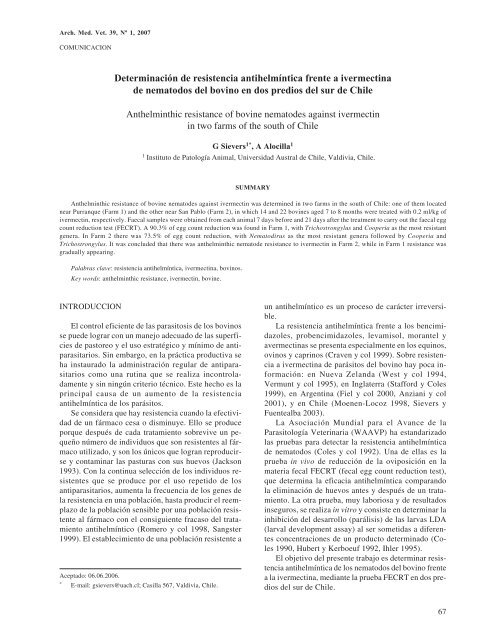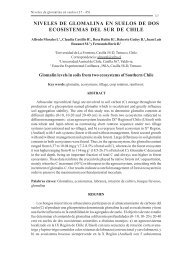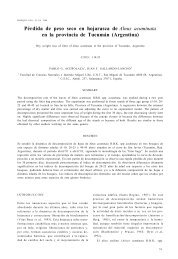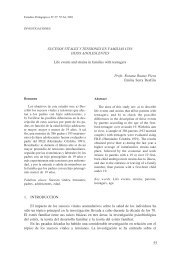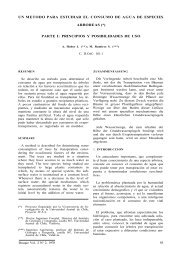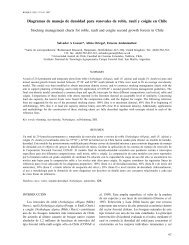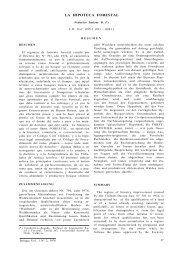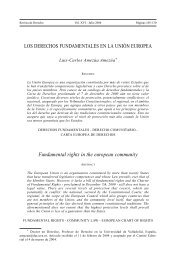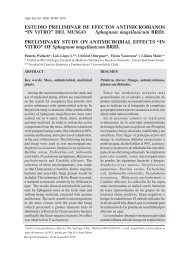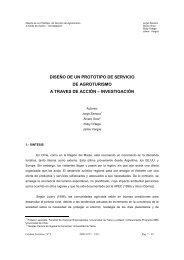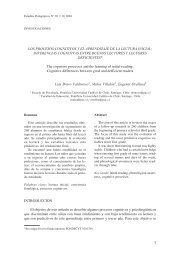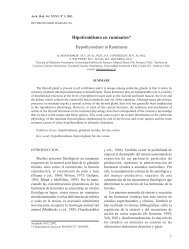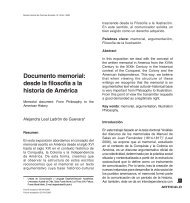Determinación de resistencia antihelmíntica frente a ivermectina de ...
Determinación de resistencia antihelmíntica frente a ivermectina de ...
Determinación de resistencia antihelmíntica frente a ivermectina de ...
You also want an ePaper? Increase the reach of your titles
YUMPU automatically turns print PDFs into web optimized ePapers that Google loves.
Arch. Med. Vet. 39, Nº 1, 2007<br />
RESISTENCIA ANTIHELMINTICA, IVERMECTINA, BOVINOS<br />
COMUNICACION<br />
<strong>Determinación</strong> <strong>de</strong> <strong>resistencia</strong> <strong>antihelmíntica</strong> <strong>frente</strong> a <strong>ivermectina</strong><br />
<strong>de</strong> nematodos <strong>de</strong>l bovino en dos predios <strong>de</strong>l sur <strong>de</strong> Chile<br />
Anthelminthic resistance of bovine nemato<strong>de</strong>s against ivermectin<br />
in two farms of the south of Chile<br />
G Sievers 1* , A Alocilla 1<br />
1<br />
Instituto <strong>de</strong> Patología Animal, Universidad Austral <strong>de</strong> Chile, Valdivia, Chile.<br />
SUMMARY<br />
Anthelminthic resistance of bovine nemato<strong>de</strong>s against ivermectin was <strong>de</strong>termined in two farms in the south of Chile: one of them located<br />
near Purranque (Farm 1) and the other near San Pablo (Farm 2), in which 14 and 22 bovines aged 7 to 8 months were treated with 0.2 ml/kg of<br />
ivermectin, respectively. Faecal samples were obtained from each animal 7 days before and 21 days after the treatment to carry out the faecal egg<br />
count reduction test (FECRT). A 90.3% of egg count reduction was found in Farm 1, with Trichostrongylus and Cooperia as the most resistant<br />
genera. In Farm 2 there was 73.5% of egg count reduction, with Nematodirus as the most resistant genera followed by Cooperia and<br />
Trichostrongylus. It was conclu<strong>de</strong>d that there was anthelminthic nemato<strong>de</strong> resistance to ivermectin in Farm 2, while in Farm 1 resistance was<br />
gradually appearing.<br />
Palabras clave: <strong>resistencia</strong> <strong>antihelmíntica</strong>, <strong>ivermectina</strong>, bovinos.<br />
Key words: anthelminthic resistance, ivermectin, bovine.<br />
INTRODUCCION<br />
un antihelmíntico es un proceso <strong>de</strong> carácter irreversible.<br />
El control eficiente <strong>de</strong> las parasitosis <strong>de</strong> los bovinos La <strong>resistencia</strong> <strong>antihelmíntica</strong> <strong>frente</strong> a los bencimise<br />
pue<strong>de</strong> lograr con un manejo a<strong>de</strong>cuado <strong>de</strong> las superfi- dazoles, probencimidazoles, levamisol, morantel y<br />
cies <strong>de</strong> pastoreo y el uso estratégico y mínimo <strong>de</strong> anti- avermectinas se presenta especialmente en los equinos,<br />
parasitarios. Sin embargo, en la práctica productiva se ovinos y caprinos (Craven y col 1999). Sobre resistenha<br />
instaurado la administración regular <strong>de</strong> antipara- cia a <strong>ivermectina</strong> <strong>de</strong> parásitos <strong>de</strong>l bovino hay poca insitarios<br />
como una rutina que se realiza incontrola- formación: en Nueva Zelanda (West y col 1994,<br />
damente y sin ningún criterio técnico. Este hecho es la Vermunt y col 1995), en Inglaterra (Stafford y Coles<br />
principal causa <strong>de</strong> un aumento <strong>de</strong> la <strong>resistencia</strong> 1999), en Argentina (Fiel y col 2000, Anziani y col<br />
<strong>antihelmíntica</strong> <strong>de</strong> los parásitos.<br />
2001), y en Chile (Moenen-Locoz 1998, Sievers y<br />
Se consi<strong>de</strong>ra que hay <strong>resistencia</strong> cuando la efectivi- Fuentealba 2003).<br />
dad <strong>de</strong> un fármaco cesa o disminuye. Ello se produce La Asociación Mundial para el Avance <strong>de</strong> la<br />
porque <strong>de</strong>spués <strong>de</strong> cada tratamiento sobrevive un pe- Parasitología Veterinaria (WAAVP) ha estandarizado<br />
queño número <strong>de</strong> individuos que son resistentes al fár- las pruebas para <strong>de</strong>tectar la <strong>resistencia</strong> <strong>antihelmíntica</strong><br />
maco utilizado, y son los únicos que logran reproducir- <strong>de</strong> nematodos (Coles y col 1992). Una <strong>de</strong> ellas es la<br />
se y contaminar las pasturas con sus huevos (Jackson prueba in vivo <strong>de</strong> reducción <strong>de</strong> la oviposición en la<br />
1993). Con la continua selección <strong>de</strong> los individuos re- materia fecal FECRT (fecal egg count reduction test),<br />
sistentes que se produce por el uso repetido <strong>de</strong> los que <strong>de</strong>termina la eficacia <strong>antihelmíntica</strong> comparando<br />
antiparasitarios, aumenta la frecuencia <strong>de</strong> los genes <strong>de</strong> la eliminación <strong>de</strong> huevos antes y <strong>de</strong>spués <strong>de</strong> un tratala<br />
<strong>resistencia</strong> en una población, hasta producir el reem- miento. La otra prueba, muy laboriosa y <strong>de</strong> resultados<br />
plazo <strong>de</strong> la población sensible por una población resis- inseguros, se realiza in vitro y consiste en <strong>de</strong>terminar la<br />
tente al fármaco con el consiguiente fracaso <strong>de</strong>l trata- inhibición <strong>de</strong>l <strong>de</strong>sarrollo (parálisis) <strong>de</strong> las larvas LDA<br />
miento antihelmíntico (Romero y col 1998, Sangster (larval <strong>de</strong>velopment assay) al ser sometidas a diferen<br />
1999). El establecimiento <strong>de</strong> una población resistente a tes concentraciones <strong>de</strong> un producto <strong>de</strong>terminado (Coles<br />
1990, Hubert y Kerboeuf 1992, Ihler 1995).<br />
El objetivo <strong>de</strong>l presente trabajo es <strong>de</strong>terminar <strong>resistencia</strong><br />
<strong>antihelmíntica</strong> <strong>de</strong> los nematodos <strong>de</strong>l bovino <strong>frente</strong><br />
Aceptado: 06.06.2006.<br />
a la <strong>ivermectina</strong>, mediante la prueba FECRT en dos pre<br />
*<br />
E-mail: gsievers@uach.cl; Casilla 567, Valdivia, Chile. dios <strong>de</strong>l sur <strong>de</strong> Chile.<br />
67
G SIEVERS, A ALOCILLA<br />
MATERIAL Y METODOS<br />
El trabajo se realizó entre junio y agosto <strong>de</strong>l año 2002<br />
en dos predios <strong>de</strong> la X Región <strong>de</strong> Chile: Predio 1, cercano<br />
a Purranque (40°53’ S, 73°09’ O), en el que se ha<br />
aplicado esporádicamente <strong>ivermectina</strong> al ganado vacuno,<br />
y Predio 2, cercano a San Pablo (40°23’ S, 73°02’<br />
O), con aplicación regular, mínimo cada cuatro meses,<br />
<strong>de</strong> <strong>ivermectina</strong> a los bovinos menores <strong>de</strong> 1,5 años durante<br />
las últimas dos décadas. Al azar se eligieron en cada<br />
predio, respectivamente, 14 y 22 bovinos <strong>de</strong> 7 a 8 meses<br />
<strong>de</strong> edad para realizar la prueba <strong>de</strong> reducción <strong>de</strong> la<br />
oviposición (FECRT).<br />
Rectalmente se obtuvieron muestras fecales <strong>de</strong> cada<br />
animal una semana antes (a.t.) y tres semanas<br />
postratamiento (p.t.) con 0,2 mg/kg <strong>de</strong> <strong>ivermectina</strong> * . A<br />
cada muestra se le realizó recuento <strong>de</strong> huevos (hpg)<br />
(Schmidt 1971) y un cultivo <strong>de</strong> larvas (Roberts y<br />
O’Sullivan 1950). El porcentaje <strong>de</strong> reducción <strong>de</strong> la<br />
oviposición se calculó mediante la fórmula (Young y col<br />
1999):<br />
% <strong>de</strong> reducción (Media hpg a.t. – Media hpg p.t.) x 100<br />
=<br />
<strong>de</strong> la oviposición<br />
Media <strong>de</strong> hpg a.t.<br />
RESULTADOS Y DISCUSION<br />
Para la prueba (FECRT), una reducción <strong>de</strong> la<br />
oviposición <strong>de</strong>spués <strong>de</strong> un tratamiento inferior al 90%,<br />
es indicativa <strong>de</strong> <strong>resistencia</strong> <strong>antihelmíntica</strong> <strong>de</strong> los parásitos<br />
involucrados (Coles y col 1992). Según este criterio,<br />
en el Predio 1 no hubo <strong>resistencia</strong> <strong>antihelmíntica</strong> al<br />
encontrarse un 90,3% <strong>de</strong> reducción <strong>de</strong> la oviposición,<br />
pero se pue<strong>de</strong> <strong>de</strong>ducir que <strong>de</strong>be estar en pleno proceso<br />
<strong>de</strong> selección <strong>de</strong> las cepas <strong>de</strong> nematodos resistentes, sien-<br />
Cuadro 1. Promedio <strong>de</strong> huevos <strong>de</strong> nematodos diferenciados<br />
por gramo <strong>de</strong> heces antes y <strong>de</strong>spués <strong>de</strong>l tratamiento con<br />
<strong>ivermectina</strong> (hpg a.t. y hpg p.t.) y porcentajes <strong>de</strong> reducción <strong>de</strong><br />
la oviposición (% red.) en bovinos <strong>de</strong> dos predios <strong>de</strong> la X Región,<br />
Chile.<br />
Mean of differentiated nemato<strong>de</strong> fecal egg count before<br />
and after a treatment with ivermectin (hpg a.t. and hpg p.t.), and<br />
percentage of reduction of the oviposition (% red.) in cattle of two<br />
farms in the 10 th Region, Chile.<br />
Predios<br />
Género<br />
Ostertagia<br />
Cooperia<br />
Trichostrongylus<br />
Nematodirus<br />
Indiferenciadas<br />
1<br />
hpg a.t. hpg p.t. % red. hpg a.t.<br />
272,3<br />
109,8<br />
55,3<br />
0,0<br />
1,8<br />
12,9<br />
19,0<br />
10,7<br />
0,0<br />
0,2<br />
95,3<br />
82,7<br />
68,0<br />
0,0<br />
88,9<br />
72,3<br />
40,0<br />
12,7<br />
34,1<br />
0,0<br />
2<br />
hpg p.t.<br />
3,2<br />
14,4<br />
2,9<br />
21,6<br />
0,0<br />
% red.<br />
95,6<br />
64,0<br />
77,1<br />
36,7<br />
0,0<br />
Total 439,2 42,8 90,3 159,1 42,1 73,5<br />
do Trichostrongylus y Cooperia los géneros más resistentes.<br />
En el Predio 2 hubo una clara <strong>resistencia</strong><br />
<strong>antihelmíntica</strong> con un 73,6% <strong>de</strong> reducción <strong>de</strong> la<br />
oviposición, con Nematodirus como el género más resistente<br />
seguido por Cooperia y Trichostrongylus (cuadro<br />
1). Ello concuerda con lo observado en Chile<br />
(Moenen-Locoz 1998, Sievers y Fuentealba 2003), en<br />
Argentina (Fiel y col 2000, Anziani y col 2001), y en<br />
Nueva Zelanda (Vermunt y col 1995). Los resultados<br />
difieren con un trabajo realizado en Inglaterra (Armour<br />
y col 1980), pero ello pue<strong>de</strong> <strong>de</strong>berse a que en ese entonces<br />
todavía no se había <strong>de</strong>sarrollado <strong>resistencia</strong><br />
<strong>antihelmíntica</strong> al producto.<br />
Resistencia <strong>antihelmíntica</strong> se ha <strong>de</strong>scrito en los<br />
nematodos <strong>de</strong> ovinos, caprinos y equinos, existiendo al<br />
respecto abundante literatura (FAO, 2003). Una <strong>de</strong> las<br />
razones que en esas especies se <strong>de</strong>sarrolle más rápido la<br />
<strong>resistencia</strong> <strong>antihelmíntica</strong> pue<strong>de</strong> <strong>de</strong>berse a la longevidad<br />
<strong>de</strong> sus parásitos, que supera los 150 días. De esta manera,<br />
al aplicar un producto sobre la población parasitaria,<br />
sobreviven algunos individuos y son sólo ellos los que<br />
producen la contaminación <strong>de</strong> las áreas <strong>de</strong> pastoreo durante<br />
un tiempo largo. En cambio, en la especie bovina<br />
los nematodos sólo viven 11 a 21 días como parásitos<br />
<strong>de</strong>ntro <strong>de</strong>l animal (An<strong>de</strong>rson, 1992) y, consecuentemente,<br />
los parásitos que sobreviven a un tratamiento logran<br />
contaminar mucho menos las pasturas, reduciéndose <strong>de</strong><br />
esa forma la posibilidad <strong>de</strong> infecciones exitosas con las<br />
cepas <strong>de</strong> nematodos resistentes y el reemplazo <strong>de</strong> la población.<br />
En ambos predios cerca <strong>de</strong> la mitad <strong>de</strong> los animales<br />
presentó una reducción <strong>de</strong> la oviposición superior al<br />
90%, lo cual indica que existen animales portadores <strong>de</strong><br />
parásitos sensibles a la <strong>ivermectina</strong>. En el Predio 1 se<br />
<strong>de</strong>tectó una <strong>resistencia</strong> mo<strong>de</strong>rada al producto porque<br />
no hubo bovinos con porcentajes <strong>de</strong> reducción <strong>de</strong> la<br />
oviposición inferiores al 40%; esto se explica porque<br />
en el predio sólo esporádicamente se aplicó <strong>ivermectina</strong><br />
a los bovinos. Sin embargo, en el Predio 2 hubo un<br />
40,9% <strong>de</strong> los animales con porcentajes <strong>de</strong> reducción <strong>de</strong><br />
la oviposición inferiores al 80%, <strong>de</strong> los cuales casi la<br />
mitad tenía una reducción <strong>de</strong> la oviposición inferior al<br />
40% (cuadro 2). La alta <strong>resistencia</strong> <strong>antihelmíntica</strong> <strong>frente</strong><br />
a la <strong>ivermectina</strong> <strong>de</strong>tectada en el predio 2 se concentró<br />
principalmente en el género Nematodirus seguido<br />
por Cooperia y Trichostrongylus; esto concuerda con<br />
observaciones previas hechas en Chile (Moenen-Locoz<br />
1998, Sievers y Fuentealba 2003). En la primera prueba<br />
<strong>de</strong> eficacia <strong>de</strong> la <strong>ivermectina</strong> realizada en bovinos<br />
en Chile (Robles 1983), se <strong>de</strong>tectó que Nematodirus<br />
seguía oviponiendo <strong>de</strong>spués <strong>de</strong>l tratamiento, y es probable<br />
que esa <strong>resistencia</strong> innata <strong>de</strong> dicho género se haya<br />
magnificado en los últimos <strong>de</strong>cenios por el extensivo y<br />
repetitivo uso <strong>de</strong> la <strong>ivermectina</strong> en el ganado vacuno<br />
<strong>de</strong>l sur <strong>de</strong> Chile.<br />
*<br />
IVOMEC (R), Merial.<br />
68
RESISTENCIA ANTIHELMINTICA, IVERMECTINA, BOVINOS<br />
Cuadro 2. Distribución <strong>de</strong> los bovinos según los porcentajes<br />
<strong>de</strong> reducción <strong>de</strong> la oviposición <strong>de</strong> nematodos parásitos<br />
postratamiento con <strong>ivermectina</strong> <strong>de</strong> dos predios <strong>de</strong> la X Región,<br />
Chile.<br />
Bovine distribution according to percentage of nemato<strong>de</strong><br />
parasite egg count reduction after treatment with ivermectin in two<br />
farms in the 10 th Region, Chile.<br />
% Reducción<br />
oviposición<br />
> 90%<br />
90-80%<br />
80-40%<br />
< 40%<br />
n<br />
7<br />
5<br />
2<br />
0<br />
Predio 1<br />
%<br />
50,0<br />
35,7<br />
14,3<br />
0,0<br />
Predio 2<br />
n %<br />
10<br />
3<br />
5<br />
4<br />
45,5<br />
13,6<br />
22,7<br />
18,2<br />
Totales 14 100,0 22 100,0<br />
El presente trabajo permite concluir que existe <strong>resistencia</strong><br />
<strong>antihelmíntica</strong> <strong>de</strong> los géneros Nematodirus,<br />
Cooperia y Trichostrongylus <strong>frente</strong> a la <strong>ivermectina</strong> en<br />
un predio y que en el otro se está iniciando el proceso <strong>de</strong><br />
selección <strong>de</strong> cepas resistentes.<br />
RESUMEN<br />
Resistencia <strong>antihelmíntica</strong> <strong>de</strong> nematodos <strong>frente</strong> a la <strong>ivermectina</strong><br />
en bovinos se <strong>de</strong>terminó en dos predios <strong>de</strong> la X Región <strong>de</strong>l sur <strong>de</strong><br />
Chile: uno cerca <strong>de</strong> Purranque (Predio 1) y otro cerca <strong>de</strong> San Pablo<br />
(Predio 2). Respectivamente, 14 y 22 bovinos <strong>de</strong> 7 a 8 meses <strong>de</strong> edad<br />
fueron tratados con 0,2 mg/kg <strong>de</strong> <strong>ivermectina</strong>. De cada animal se obtuvo<br />
materia fecal 7 días antes y 21 días <strong>de</strong>spués <strong>de</strong>l tratamiento para realizar<br />
la prueba <strong>de</strong> reducción <strong>de</strong> la oviposición (FECRT). Se encontró un<br />
90,3% <strong>de</strong> reducción <strong>de</strong> la oviposición en el Predio 1, y los géneros<br />
más resistentes fueron Trichostrongylus y Cooperia. En el Predio 2<br />
se encontró un 73,5% <strong>de</strong> reducción <strong>de</strong> la oviposición con el género<br />
Nematodirus como el más resistente seguido por Cooperia y<br />
Trichostrongylus. Se concluyó que existe <strong>resistencia</strong> <strong>antihelmíntica</strong><br />
<strong>frente</strong> a la <strong>ivermectina</strong> en los nematodos <strong>de</strong>l bovino en el Predio 2 y<br />
que en el Predio 1 está en proceso <strong>de</strong> formación.<br />
REFERENCIAS<br />
An<strong>de</strong>rson, RC. 1992. Nemato<strong>de</strong>s parasites in vertebrates. Their<br />
<strong>de</strong>velopment and Transmission. CAB International, Wallingford,<br />
U.K.<br />
Anziani O, G Zimmermann, A Guglielmone, R Vásquez, V Suárez.<br />
2001. Avermectin resistance in Cooperia pectinata in cattle in<br />
Argentina. Vet Rec 149, 58-59.<br />
Armour J, K Bair<strong>de</strong>n, JM Preston. 1980. Anthelmintic efficiency of<br />
ivermectin against naturally acquired bovine gastrointestinal<br />
nemato<strong>de</strong>s. Vet Rec 107, 226-227.<br />
Coles GC. 1990. Recent advances in laboratory mo<strong>de</strong>ls for evaluation<br />
of helminth chemotherapy. Br Vet J 146, 113-119.<br />
Coles GC, C Bauer, FHM Borgstee<strong>de</strong>, TR Klei, MA Taylor, PJ Waller.<br />
1992. World Association for the Advancement of Veterinary<br />
Parasitology (WAAVP) methods for <strong>de</strong>tection of anthelmintic<br />
resistance in nemato<strong>de</strong>s of veterinary importance. Vet Parasitol<br />
44, 35-44.<br />
Craven J, H Bjorn, EH Barnes, SA Henriksen, P Nansen. 1999. A<br />
comparison of in vitro tests and a faecal egg count reduction test<br />
in <strong>de</strong>tecting anthelmintic resistance in horse strongyles. Vet<br />
Parasitol 85, 49-59.<br />
FAO (2003). Resistencia a los antiparasitarios. Estado actual con énfasis<br />
en América Latina. Boletín 157. Roma.<br />
Fiel C, C Saumel, P Estefan, E Rodríguez, G Salaberry. 2000. Resistencia<br />
<strong>de</strong> los nematodos Trichostrongyli<strong>de</strong>os –Cooperia y<br />
Trichostrongylus– a tratamientos con avermectinas en bovinos <strong>de</strong><br />
la Pampa Húmeda, Argentina. Rev Med Vet 81, 310-315.<br />
Hubert J, D Kerboeuf. 1992. A microlarval <strong>de</strong>velopment assay for the<br />
<strong>de</strong>tection of anthelmintic resistance in sheep nemato<strong>de</strong>s. Vet Rec<br />
130, 442-446.<br />
Ihler CF. 1995. Use of two in vitro methods in the <strong>de</strong>tection of<br />
benzimidazole resistance in equine small strongyles (Cyathostoma<br />
spp.). Vet Parasitol 65, 117-125.<br />
Jackson F. 1993. Anthelmintic resistance - the state of play. Br Vet J<br />
149, 123-138.<br />
Moenen-Locoz AS. 1998. Estudio comparativo <strong>de</strong> la efectividad <strong>de</strong><br />
cinco productos comerciales que contienen Ivermectina <strong>frente</strong> a<br />
parásitos gastrointestinales <strong>de</strong>l bovino. Tesis, M.V., Universidad<br />
Austral <strong>de</strong> Chile, Facultad <strong>de</strong> Ciencias Veterinarias, Valdivia,<br />
Chile.<br />
Robles S. 1983. Efecto <strong>de</strong>l fármaco Ivermectina (Ivomec) sobre la<br />
eliminación <strong>de</strong> huevos <strong>de</strong> parásitos gastrointestinales en las fecas<br />
<strong>de</strong> terneros en sus primeros meses <strong>de</strong> vida. Tesis, M.V., Universidad<br />
Austral <strong>de</strong> Chile, Facultad <strong>de</strong> Ciencias Veterinarias, Valdivia,<br />
Chile.<br />
Roberts F, PJ O’Sullivan. 1950. Methods for eggs count and larval<br />
cultives for strongylus infesting the gastrointestinal tract for cattle.<br />
Austr J Agr Res 1, 99-102.<br />
Romero J, Boero C, Vásquez R, Aristizábal MT, Baldo A. 1998. Estudio<br />
<strong>de</strong> la <strong>resistencia</strong> a antihelmínticos en majadas <strong>de</strong> la<br />
mesopotamia argentina. Rev Med Vet 70, 342-346.<br />
Sangster NC. 1999. Pharmacology of anthelmintic resistance in<br />
cyathostomes: will it occur whith the avermectin/milbemycins?<br />
Vet Parasitol 85, 189-204.<br />
Schmidt U. 1971. Parasitologische Kotuntersuchung durch ein neues<br />
Verdünnungsver-fahren. Tierärztl Umsch 26, 229-230.<br />
Sievers G, Fuentealba C. 2003. Comparación <strong>de</strong> la efectividad<br />
<strong>antihelmíntica</strong> <strong>de</strong> seis productos comerciales que contienen<br />
lactonas macrocíclicas <strong>frente</strong> a nematodos gastrointestinales <strong>de</strong>l<br />
bovino. Arch Med Vet 35, 81-88.<br />
Stafford K, Coles GC. 1999. Nemato<strong>de</strong> control practices and<br />
anthelmintic resistance in dairy calves in the south west of England.<br />
Vet Rec 144, 659-661.<br />
Vermunt J, D West, W Pomroy. 1995. Multiple resistance to ivermectin<br />
and oxfendazole in Cooperia species of cattle in New Zealand.<br />
Vet Rec 143, 443-446.<br />
West DJ, J Vermunt, W Pomroy, H Bentall. 1994. Inefficacy of<br />
ivermectin againts Cooperia spp infection in cattle. N Z Vet J 42,<br />
192-193.<br />
Young K, V Garza, K Snow<strong>de</strong>n, RJ Dobson, D Powel, TM Craig.<br />
1999. Parasite diversity and anthelmintic resistance in two herds<br />
of horses. Vet Parasitol 85, 205-214.<br />
69


